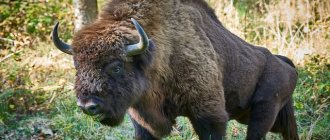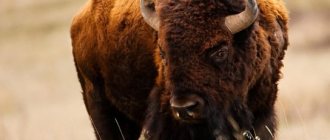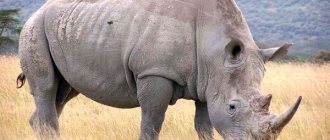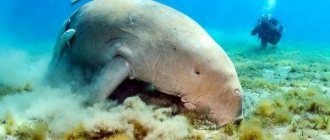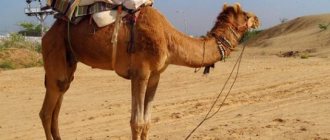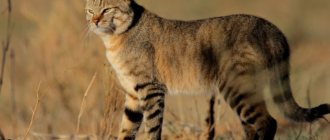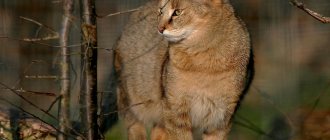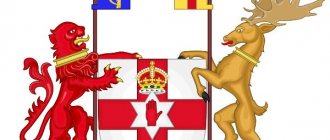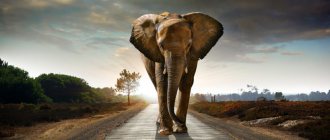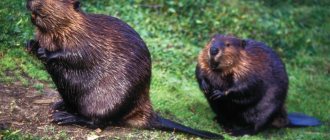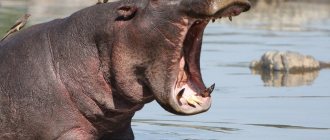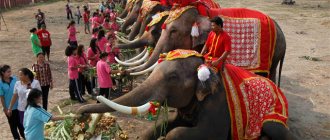Bison are a species of large artiodactyl mammals from the bovid family. The ancient ancestors of modern bison appeared on the planet even before the onset of the Pliocene era (5.5 million years ago). Initially they inhabited the southern regions of Europe, and over time they spread throughout the entire European continent, as well as in the northern regions of Asia and North America. Primitive bison were at least twice the size of modern ones. About 14 thousand years ago, the Eurasian animal population became extinct. In modern fauna, species related to ancient bison are bison living in Europe and bison living in America.
By the beginning of the 19th century, the estimated number of bison reached 40 million individuals, but the mass extermination of bison in the United States over the course of a century led to a sharp decline in the population and threatened the existence of the species.
Characteristics and description
Bison lead a social lifestyle, forming numerous herds. In the wild, the number of groups often reached 15-20 thousand individuals. Unlike other herd animals that have one dominant male, bison are dominated by several of the largest and most experienced animals.
During the day, the herd moves across the plain in search of lush grass. At night, animals sleep, and they can wake up several times a night and graze.
To exchange information, bison use several types of sounds, reminiscent of mooing and dull growls. They have a very well developed sense of smell, which makes it possible to hear the approach of an enemy from a distance of 2-3 km.
What does it look like
The appearance of the bison has the following features:
| Body | Massive and compact, a hump is noticeable on the back, the front part is thicker and more developed |
| Head | Large with a wide forehead and an elongated muzzle, the ears are small and almost invisible due to the thick long fur |
| Limbs | Short, equal length |
| Tail | Medium length, with a tassel at the end |
| Horns | Short, thick, curved inward |
The bison's body is covered with fur; it is noticeably longer on the front of the body and limbs. The longest fur covers the shoulders and neck, and also forms a beard at the bottom of the head. The color is uniform, the color can vary from brown to dark brown.
Dimensions
The American bison is considered the most massive artiodactyl. The weight of an adult male reaches a ton. The record weight is 1200 kg. The body length reaches 3.7 m, and the height at the highest point of the hump is 2 m.
The size of females is somewhat smaller: the weight is within 700 kg, and the body length is 2.7-3 m. A newborn calf weighs about 25 kg.
Bison and bison: differences
Bison (Bison bonasus)
Both species are very similar in appearance. They can be distinguished by the following characteristics:
- if you look at a bison from the side, its body is more compact, bison have an elongated body and their legs are longer;
- bison are larger;
- The head of bison is larger and set low, the hump is higher;
- bison have longer horns and tail.
North American animals change their fur during the summer months; bison do not have a pronounced molting period.
How many years do they live
For bison living in natural conditions, the average life expectancy was 14-18 years.
Currently, about 95% of animals are privately owned. Protecting bison from natural enemies and providing favorable living conditions in nature reserves and farms made it possible to increase the life cycle to 25-28 years.
Kinds
The American bison is one of two species in the bison genus. The classification distinguishes two subspecies of the animal. They differ in size, fur and some features of body structure.
- Wood bison.
Forest (Bison athabascae)
Distributed in the northern part of its range. Adults are larger and more massive, covered with dark brown fur.
The head is slightly extended forward, in the upper part there is long fur that hangs down, due to which the horns are almost completely visible. The top point of the hump is in front of the forelimbs.
- Steppe bison.
Steppe (Bison bison)
It is somewhat smaller in size than forest bulls. The head is more massive, covered with thick hair, forming a kind of cap that partially hides the horns and ears. The highest point of the withers is located above the front legs. The front part of the body is covered with thicker and longer fur; a beard is clearly visible on the lower part of the neck.
Fur color is brown, with a reddish or reddish tint.
Steppe bison have a larger population. It was this subspecies that was used to create commercial herds and crossbreed with bulls to produce improved breeds of cattle.
Hybrids
bison
Bison and bison belonging to the same genus are not only similar in appearance, but can also produce offspring when crossed. A hybrid of bison and American bison, depending on the gender of the representatives of the original species, is called bison or bison bison. Unlike most hybrids, which are not able to reproduce, crossbreeds of bison and bison produce offspring, including when crossed with individuals of the parent species.
The first hybrids were obtained at the beginning of the last century. In the middle of the last century, bison were settled in a reserve in the Caucasus, where they successfully took root and live to this day. In Russia, animals are bred in a nursery near St. Petersburg.
Most of the domesticated bison, which are kept on ranches for meat and hides, are also not purebred. Hybrids of bulls and bison are called buffalo or cattalo.
Victims of progress
Bison hunting became truly barbaric when the Industrial Revolution took hold in Europe. Countless machines in mushrooming factories at that time spun using leather drive belts, as a result of which the demand for durable, high-quality leather sharply increased. Trade and industrial companies began to buy bison skins in huge quantities in America. As a result, demand generated supply. Both white hunters and the Indians themselves began the mass destruction of these animals. Every day, huge herds were driven into the abysses, and there the bison died in the thousands. They were skinned, and the carcasses were left to be torn to pieces by wolves and jackals. In exchange for skins, hunters received knives, axes, guns, gunpowder and whiskey. If at the beginning of the century several thousand buffalo skins went on sale annually, then by 1830 this number had increased to 130 thousand!
Where does it live?
Bison are found exclusively on the North American continent. Their habitat covers most of the continent from the southern Canadian provinces to the states of the central United States.
Where does he live?
The natural habitat of steppe bison is the prairie located in the central part of the continent. The forest subspecies of the animal is found in the northern and eastern parts of its range, where forest-steppes and steppes turn into the natural zone of deciduous and mixed forests. Bison inhabit plains covered with sparse forests with numerous edges, clearings and clearings.
The herds living in natural conditions made seasonal migrations, covering considerable distances. Before the onset of winter, bison moved to the southern part of the continent, and in the spring they returned to their usual habitat. Currently, the habitat of almost all bison living on the planet is limited, so the animals have stopped making long journeys along the continent.
In our country, animals live in the Prioksko-Terrasny Nature Reserve near Moscow, the Lena Pillars National Park and in the territory of other nature reserves and sanctuaries.
CAMEL
What does it eat?
Bison are herbivorous species. Every day, each adult animal consumes about 30 kg of green mass. The diet is based on grass, young shoots of bushes and trees, and leaves. In winter, bison tear up the snow and eat moss, lichen, fallen leaves, and gnaw branches. Captive animals are fed grains.
Bison need a lot of water every day, so they try not to move away from watering holes.
ZEBRA
Nutrition
The bison's diet is based on plant foods, while the bull is a herbivore. To saturate one individual per day, at least 28-30 kg of vegetation is required. Nutritional value for herbivorous giants is:
- herbaceous plants;
- cereals;
- young growth, shoots of bushes;
- lichens;
- moss;
- branches;
- plant foliage.
In lowland bison, the grassy cover of steppes and meadows predominates in their food. Forest inhabitants mostly eat branches and foliage. Every day, herds of bison gather at the reservoir to quench their thirst.
Bison grazing on farms is carried out in the early morning or evening. During the hot midday hours, animals sit in the shade of large trees and hide in the forests.
Wild bison roam whenever possible in search of food. During the cold season, lack of food affects the quality of wool. Animals suffer from hunger and cold. In winter, grass rags taken from under snowdrifts and plant branches become food.
Animals dig out snow debris, dig holes with their hooves and foreheads. Like bison, they move their muzzles deeper into the ground in search of roots and stems. It is no coincidence that for this reason many individuals develop bald spots on their heads. When bodies of water are covered with ice, animals eat snow.
Reproduction
Bison are not monogamous animals. During the rutting season, females and males can mate with several individuals of the opposite sex. The mating season for bison begins in May and can last until the middle and sometimes until the end of summer. At this time, the character of the males changes noticeably: usually calm animals become aggressive and often fight. During the collision, the males roar and bump their foreheads. Often, as a result of blows from the horns, weaker opponents receive serious injuries and even die.
Pregnancy in bison lasts a little over 9 months. Before giving birth, the female separates from the herd and finds a nearby place in the thicket of bushes or in dense tall grass. As a rule, one cub is born; the birth of two babies is very rare for these artiodactyls.
The mother licks the newborn, who almost immediately stands up and can follow the herd. Calves do not have horns or a hump, and also differ from adults in having a lighter coat color. Initially, they feed exclusively on mother's milk, the fat content of which reaches 12%. The female continues to feed the calf even after it begins to graze. Typically, lactation continues for 10-12 months after birth.
The first year of life is the most difficult for young bison, as many of them die during attacks by predators. Animals that have reached the age of three are ready to breed.
From hunting to extermination
Of course, bison have been hunted for a long time. For many Indian tribes, these animals were a real breadbasket, carefully supplying meat for food and skins for clothing and wigwams. The Indians roamed along with giant herds, and neither one nor the other experienced any inconvenience from this. True, it cannot be said that the indigenous people of America and the pale-faced hunters who appeared later treated the preservation of the bison population with special trepidation. Abundance breeds wastefulness, and the history of the Wild West describes many cases of the senseless extermination of huge numbers of bison by the same Indians. Nomadic white traders and trapper hunters witnessed, and often took part in, a cruel and unprofitable, as they would say now, hunt: Indian beaters set fire to the grass in front of the herd and, with screams and noise, drove some of the bison that strayed from the herd into a deep ravine. Then the hunters ran up to the wounded animals and finished them off with spears and arrows. For food, the Indians took the meat of young females, but did not even look at the dead males. Sometimes only the tongues of animals were cut out as a delicacy. Along the way, a countless number of animals could have died from the fire, but the tribe did not care much about this.
Natural enemies
The impressive size of bison allows them not to be afraid of most common predators in North America. Natural enemies of bison include grizzly bears, wolves and cougars. Mostly calves and old individuals suffer from their attacks.
When attacked by predators, bison run away. After some distance, the animal can turn sharply, lower its head and meet its pursuer with its horns, inflicting dangerous and even fatal wounds on it. Even though bison live in herds, they do not protect each other when attacked by predators. In addition, there are cases when, when attacked by wolves, animals knocked down one of their relatives, which greatly facilitated the task of the wolf pack. Probably, in this way the artiodactyls got rid of sick and old animals.
WOLF
Apocalypse
The widespread extermination of bison reached its peak in the 60s of the 19th century, when construction of the transcontinental railroad began. Bison meat was used to feed a huge army of road workers, and the skins were sold. Specially organized groups of hunters pursued bison everywhere, and soon the number of animals killed was approximately 2.5 million per year. A certain William Cody, known as Buffalo Bill, supplied meat to railroad workers and killed 4,280 bison in 18 months! One of the many gangs that fed on this field destroyed 28,000 bison in a year. Railway advertisements promised passengers bloody entertainment: shooting at bison directly from the windows of the cars. The hunters sat on the roofs and platforms of the train and fired in vain at the grazing animals. No one picked up the carcasses of the killed animals, and they were left to rot on the prairies. Passing through huge herds, the train left behind hundreds of dying or maimed animals. There was another reason for such ruthless extermination - the fight against the notorious Indians. The white newcomers quickly realized that bison were the basis of the existence of many Indian tribes. By destroying the bison, the palefaces doomed the indigenous people of America to starvation. As a result of all these barbaric actions, more than 5 million bison were killed in just a couple of years.
Interesting Facts
- The name of the species comes from the Latin “bison” (meaning wild bull) or the ancient German “wisand”, which was the name for strong and unpleasant-smelling animals.
- The number of bison that lived on the North American continent before the arrival of the colonists can be judged by the fact that Manhattan Island in New York appeared on a sandbar formed from the remains of drowned animals that crossed the Hudson during seasonal migrations.
- By the end of the 19th century, only a few hundred bison remained in North America. In 1872, the first protected area, known today as Yellowstone National Park, was created. The creation of nature reserves, a ban on hunting and other environmental measures made it possible to avoid the complete extermination of the species. Today, the number of bison in the world is estimated at 30-35 thousand individuals. Due to the stable growth of the population in the wild, the status of the species in the international Red Book was changed to “close to vulnerable”.
- Bison in a herd are not afraid of wolf packs. Knowing this, the Indians covered themselves with wolf skins and came close enough to the animals, which often ensured the success of the hunt.
- As a result of keeping cows and buffaloes together, the domesticated inhabitants of the prairies began to suffer from bovine tuberculosis and brucellosis. Because the ranch's bison were used to breed and restore the species to the reserves, some of the wild herds are also susceptible to these types of diseases.
- Bison are capable of speeds of about 50-60 km/h, while jumping over obstacles up to 1.8 m high.
Legacy of the Stone Age
Archaeological excavations show that this method of obtaining food has been used by people since ancient times. In many places where Stone Age man hunted, scientists find huge piles of bones. The ancestors of the Indians did the same. Archaeologists conducting excavations in the southern United States, in Colorado, discovered about two hundred bison skeletons in one of the canyons. A herd of wild bulls camped here eight thousand years ago. The ancient Indians used some of the prey, but, as the study showed, they did not even touch several dozen carcasses. Many historians believe that the hunter, armed with stones and a spear, was directly to blame for the extinction of ancient large animals. With the help of his primitive weapons, he could kill several small animals, but fire and the earth's landscape helped him destroy large animals by the hundreds. Such hunting methods, coupled with periodic epidemics among animals and frequent droughts, would sooner or later lead bison to extinction. But the white aliens managed to speed up this terrible process many times over.
